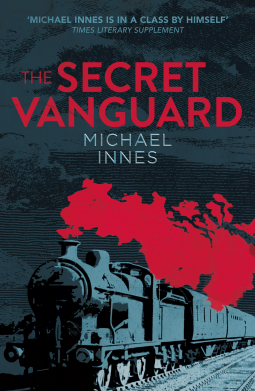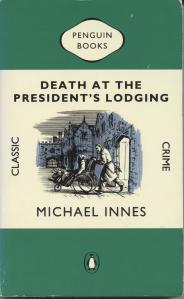When people disappear, one hears talk of Milton Porcorum

Agora Books|3 May 2018|384 pages|e-book|Review copy|4*
Operation Pax by Michael Innes, an Inspector Appleby mystery, was originally published in 1951, and in the United States as The Paper Thunderbolt.
I enjoyed Operation Pax much more than I expected I would when I began reading it. Almost the first third of the book is about a petty thief, Alfred Routh, an unpleasant little man, who for much of the time is confused and bewildered by his own thoughts and fears, which plunge him into utter panic. As his fears spiral into a engulfing and terrifying fantasy, he finds himself in the little village of Milton Porcorum and here is where his nightmare really begins. A tall man with square shoulders ushers him within the walls of Milton Manor, a most bizarre place where Routh fears for his life. A place where experiments are carried out in a sequence of laboratories and dangerous animals are kept in enclosures surrounding the house. A place with a mysterious and unnamed ‘Director’ who masterminds the whole operation.
After that rather surreal opening the action moves to Oxford and a rather more normal atmosphere – but strange and disturbing things are happening there too. An undergraduate, Geoffrey Ourglass, has disappeared and both his uncle, a university don and his fiancée, Jane, Sir John Appleby’s younger sister are concerned for his safety. Jane enlists her brother’s help to find Geoffrey – and so begins an adventure involving the dons of St Bede’s college, a group of boisterous children on bikes, European refugees as well as Appleby, Jane and her taxi-driver, Roger Remnant. It takes us from St Bede’s college into the depths of the Bodleian Library, on the trail of clues, around Oxford and out into the surrounding countryside in a thrilling chase against time to rescue Geoffrey. There are strange phone calls and most mysterious of all a formula written on a scrap of paper that threatens the safety of the whole world – it must be found and destroyed.
I loved a number of things about this book – the descriptions of the dons and their ‘erudite’ conversations, the setting in Oxford and particularly in the Bodleian library is brilliant, and the children are lively, argumentative and entertaining, providing comic relief. It is pure escapism with an incredibly unbelievable plot and strange eccentric characters that wormed their way into my mind and made it a book I just had to finish. Once it got going it is fast- paced and it kept me guessing about the identity of the mastermind behind the threat to mankind – I was completely wrong!
The Author
Michael Innes is the pseudonym of John Innes Mackintosh Stewart (1906 – 1994), a British scholar and novelist. He was born near Edinburgh, the son of a Scottish professor, and attended Edinburgh Academy, then Oriel College, Oxford where he won the Matthew Arnold Memorial Prize in 1939 and honours in English. He was a Lecturer, then a Professor in English at different universities, including Adelaide University in South Australia from 1935 to 1945. He became an Oxford fellow in 1949 and finished his academic career in 1973 as a Student (Fellow) at Christ Church Oxford.
As Michael Innes, he published numerous mystery novels and short story collections, most featuring the Scotland Yard detective John Appleby.
My thanks to Agora Books for an e-book review copy via NetGalley


 I’m currently reading Death at the President’s Lodging – a used Penguin Books edition published in 1958, one of the green and white crime fiction books.
I’m currently reading Death at the President’s Lodging – a used Penguin Books edition published in 1958, one of the green and white crime fiction books.